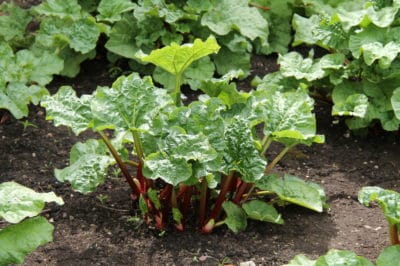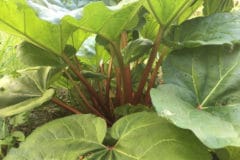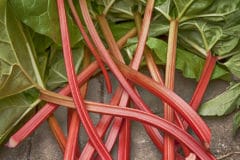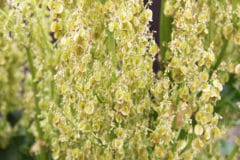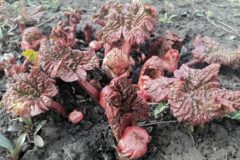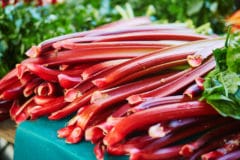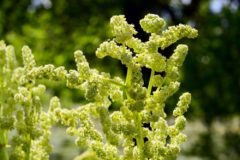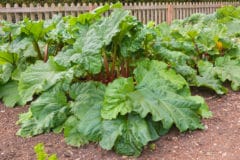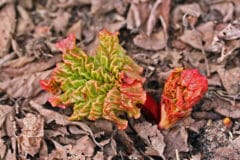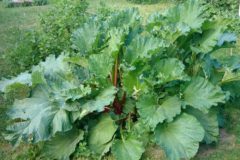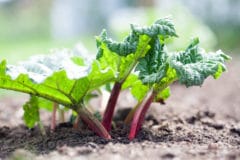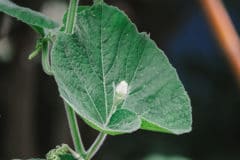What do I need to know about rhubarb?
Rhubarb is a perennial plant and is technically a vegetable; this fact is surprising to many since rhubarb is often used in sweet treats and desserts, in addition to soups and stews.
How does rhubarb stack up nutritionally?
Rhubarb is low calorie (26 calories per one cup), low carb, fat-free, and a source of potassium, calcium, and vitamin C. Each cup also provides 2.2 grams of fiber.
Isn’t rhubarb poisonous?
The stalks of the rhubarb plant are delicious and completely safe to eat, however, the leaves and roots are poisonous. They contain oxalic acid, which is hazardous to humans and should not be consumed. This toxic compound is not present in the stalks.
While rhubarb leaves contain various acids that should not be eaten, it is perfectly safe to use them in your compost. The toxins in the leaves break down easily in the process of decomposing.
What do I need to do before planting?
Your plants will need good soil and nutrition to thrive, so soil prep is a big deal. You want to select an area of your garden that is well-drained and receives some sunlight. Weed the area to be planted before anything else; get rid of all perennial weeds so that your rhubarb won’t have to fight for nutrients.
How do I prepare the soil for the plants?
Once the weeds are gone, work some nutrients into your soil. You’ll want to use something natural, to protect your plants from the damage that chemical fertilizers and soil supplements can cause. If your soil doesn’t drain well, you can add some sand at this point, as well.
What should I use to add nutrients to my soil?
You want to stick to organic, natural fertilizers; chemical and synthetic products can be damaging or lethal to your plants in some circumstances. With organic compost and manure, you cannot use too much; your plants will be well fed and you’ll have no concerns about damage to your plant’s roots.
There’s a wide assortment of fertilizers you can use:
- Organic compost
- Rotted manure
- Fish emulsion
- Soybean, alfalfa, fish, or blood meal
- Coffee grounds
Coffee grounds are more effective when they are added to compost, but can be used directly on the soil if necessary.
Will rhubarb grow from seeds?
When growing rhubarb from seeds, there is a timeline involved in getting your starts ready for spring planting. It’s relatively simple to start your plants from seeds, as long as you do it at the right time.
You’ll actually start your seeds in pots, sometime between very late summer and early fall. Place these pots in a cool, sunny indoor area or a shady spot outside. Transplant your rhubarb starts into your garden when they are about four inches tall.
How do I grow rhubarb from root sections?
Rhubarb root crowns can be dug up, separated into sections, and replanted to grow again; in fact, this is a great practice to help keep your older plants healthy. Root crowns should be planted in spring, once the ground has begun to thaw and the earth is workable. You can also buy rhubarb crown sections at garden stores or nurseries.
To start a plant from a root section, simply prepare the soil with compost and water, plant your root segment and cover it with soil, then place a compost/straw mulch to keep the plant nourished and moist while it grows.
How big should my planting holes be?
Once your soil is properly prepared and your plants are ready to go in the ground, it’s time to dig your holes for planting.
Your rhubarb holes should be about the size of a bushel basket. Once dug, you’ll put some soil mixed with compost and manure into the hole, creating a mound about two inches tall. Set your crown section on the mound, roots draping over the sides, and fill in; the rhubarb should be about two inches below the soil surface when you’re done.
This planting method works for both spring and autumn planting.
How do I maintain and protect my rhubarb?
Rhubarb is a pretty strong, hearty plant and doesn’t require much in the way of maintenance. A few minutes a week, and a small amount of effort will keep your rhubarb healthy and productive. Good watering, mulching, and occasional fertilizing with compost will also help keep your plants producing for years.
Do I need to add mulch?
As your plants grow, you’ll want to keep an eye on them; once they’ve broken through the ground, it’s a good idea to apply a mulch of straw mixed with manure around the base of the plants. This will help your rhubarb stay moist, while also adding nutrients to the soil and discouraging the growth of weeds.
Do I need to worry about seed pods and flowers?
Sometimes, a rhubarb plant begins to develop seed pods or flower stalks; these growths siphon the plant’s nutrients, they and will reduce your harvest. To remove those growths, use a sharp knife to cut off the pods, which appear around the based of the plant, and the flowering stalks.
How much water will my rhubarb need?
Throughout the growing season, your rhubarb plants will need little attention. The majority of your effort will consist of weeding and watering. During the warm summer months, even with that layer of mulch in place, your plants will need to be kept moist. Watering is vital to healthy plants and a good crop.
What about weeds?
Weeds, like seed pods, vie for the nutrients your rhubarb needs to grow. Getting rid of these interlopers as soon as you spot them will help your rhubarb to be as productive as possible.
Are there companion plants that will help my rhubarb grow?
Plants like onion and garlic are good neighbors for rhubarb as are broccoli, cabbage, kale, turnips, and the like.
What about rhubarb diseases?
Most rhubarb diseases are caused by fungi and will affect leaves, roots, and even stalks; the first sign of disease is red or yellow-green spots on the plant’s leaves. To protect against these fungi(ascochyta and ramularia, for instance), plant in well-drained soil.
If the fungus has not spread to the stalks, the plant is still okay to eat; just remove the affected leaves and discard them completely; your stalks should be fine. If your rhubarb continues to show signs of fungal infection, you’ll have to destroy the plant completely so it doesn’t infect the rest of your crop.
What should I do about bugs?
Because of the toxicity of its leaves, rhubarb doesn’t tend to attract a lot of insects or bugs. The most common pests to be found in your rhubarb patch are rusty snout beetles and slugs. Beetles will leave black spots on your plant’s stems while jagged holes indicate slug activity.
To maintain a natural garden, beetles can be picked off, or you can use any of several natural treatments, such as oil and soap mixed with water and sprayed all over your plants.
For slugs, you can use slug traps if you like. If you prefer something you can make at home, simply dig a small hole in your garden, set a small bowl inside1855*, and fill 2/3 full with beer. Slugs are attracted to the beer, crawl into the bowl, and don’t come out.
When is my rhubarb ready to harvest?
Knowing when and how to harvest, and when not to, will help you keep your plants strong and ready to produce again next season.
Don’t wait for your rhubarb stalks to turn red before harvesting; that is not an indicator of ripeness. Stalks are ready to be harvested when they are between seven and 15 inches long. You’ll find that your rhubarb is ripe for the majority of the summer, however, waiting for the stalks to reach a good length will help preserve the plant’s health.
How do I harvest my rhubarb?
Start harvesting from the outside of the plant, removing the largest stalks first. Leave the smaller stalks to continue growing; you can harvest rhubarb several times during the growing season.
To harvest a rhubarb stalk, grasp it low, near the ground, and gently pull it; if the stalk doesn’t come out easily, don’t force it. should you find that harvesting this way causes you to remove roots with the stalk, you can opt to cut the rhubarb, instead. Using a sharp knife, simply cut the stalk off as near to ground level as possible.
Is that all there is?
Yes! It really is that easy. Growing rhubarb is neither labor intensive nor complicated. A little compost, plenty of water, a small amount of time and attention, and you’ll be cooking, canning, and enjoying all kinds of foods that feature rhubarb. And when someone compliments your fantastic pie, scrumptious jelly, or delicious candy, you can say, “Thanks, I grew it myself!”
